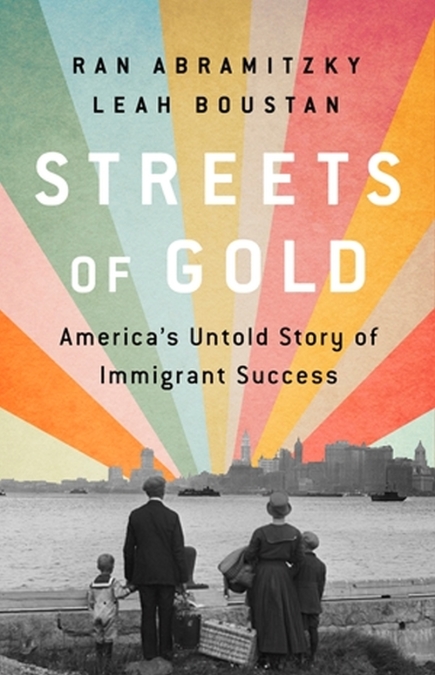John Kroencke: “Streets of Gold” by Ran Abramitzky and Leah Boustan

Ran Abramitzky and Leah Boustan provide a compelling, data-driven account of the multigenerational progress of immigrants to the United States in Streets of Gold: America’s Untold Story of Immigrant Success. This book is the result of years of research using ancestry.com data to provide clear evidence on a topic that is often spoken about with references to myths or ideological beliefs. This highly engaging and accessible book offers a blend of this pioneering original research (which yielded the two economic historians multiple articles published in leading economics journals) and the broader social science literature.
Throughout the book, the authors use their assembled data to check whether various widely held beliefs about immigration hold up. They look not just at economic success in the form of the incomes of immigrants and their descendants but also at social assimilation. Along the way, they introduce real immigrants as representative examples of their broader findings.
After an introductory chapter, a methodological chapter, and a brief history of immigration to the United States, the core findings of the researchers are presented in four middle chapters. In turn, they examine a) the economic outcomes for immigrants themselves, b) the economic outcomes for their children, c) cultural assimilation, and d) potential harms to native-born Americans. The final chapter looks at attitudes towards immigrants and uses the findings presented in the book to craft a new evidence-based, pro-immigrant narrative.
The findings of the book suggest that the success of immigrants is clear in the medium to long term. They argue that the rates of assimilation (established by analysing data from name choices, intermarriage, and language abilities) and economic mobility of the descendants of immigrants in the distant past are romanticised and that contemporary immigrants are often judged against these myths.
The scale of the data, new techniques, and the power of contemporary computing allow quantitative insights that were simply impossible before. The authors can follow immigrants across generations to see the path of not just immigrants but their descendants. They can compare the paths of families descended from immigrants from different countries and with different skill levels. The scale and specificity of the data collected and analysed allows nuance and specificity in a topic that often draws out more passion than intellect.
In addition to presenting the authors’ own findings, the book carries out a review of some of the existing economics literature across the relevant chapters. Taken together, the literature provides empirical tests to test theoretical predictions and economic theory to explain empirical findings. For the most part, it finds that many concerns about immigration are overblown (perhaps most notably the purported negative effect on native wages).
The second chapter helpfully summarises the history of immigration to the United States, explaining why immigrants from Europe (and increasingly Southern and Eastern Europe) came to the United States during the Age of Mass Migration, why fewer immigrants came during the early twentieth century, and why immigrants to the United States since the 1960s have mostly come from Asia and Latin America.
The authors manage to draw general conclusions while emphasising that immigrants are unsurprisingly heterogeneous. Some immigrants arrive in the United States with high skills (and determination), which allows them to outearn native-born Americans. On the other hand, those who arrive without skills valued in the marketplace are less able to earn close to the average American—though often far more than in their native country. While their incomes catch up as they gain skills (most notably language skills), they often fail to catch up over their lifetime.
In aggregate, the gap between immigrant earnings and native earnings nearly halves: “shrinking from 30 percent upon arrival to 16 percent twenty years later” (page 75). Furthermore, through pioneering data analysis, the book shows that the children and grandchildren of even the least well-off immigrants continue to converge with the rest of the population. In fact, “the children of first-generation immigrants growing up close to the bottom of the income distribution (at the 25th percentile) are more likely to reach the middle of the income distribution than are children of similarly poor US-born parents” (page 85).
The authors do not shy away from showing variation in the performance of the children of poor immigrants by country of origin or the lingering divergence across generations (though nearly all outperform children of similarly poor natives even if you restrict the comparison to white natives). On pages 94–95, the authors show that while most of the circa 1980 cohort of the children of immigrants who earned at the bottom of the income distribution earned more than similar natives, some do marginally better (e.g., France or Honduras) and some do dramatically better (e.g., India or China).
Basic facts about immigrants, both past and present, escape even high-ranking officials. For instance, two countries that stand out in the data both start with the same letter “N.” Immigrants from one country are “the most educated population in the United States, with 81 percent holding at least a college degree” (page 59), while immigrants from another, “…were among the lowest-paid immigrant groups in the early twentieth century, earning $4,000 less annually than US-born workers (in today’s dollars) and failing to make up much of this earnings gap even after thirty years in the country” (page 73). The first is Nigeria, and the second is Norway—the authors note that this is the opposite of President Trump’s infamous 2018 assessment of the two countries.
The authors argue that contemporary cultural compatibility assessments must prove they are different than past assessments of Catholics and other migrants (most notably East Asians), who have now clearly integrated into the mainstream of American culture.
One important reason why immigrants and their children succeed is that immigrants move to areas within the United States with greater opportunity. Unlike Americans, who are embedded (or stuck) in local communities that may offer fewer opportunities, immigrants can and often do choose to live in cities with strong labour markets that offer the best chance of success. In fact, while “children of immigrants outearn other children in a broad national comparison, “this can be explained in part by geographical opportunity as “they do not earn more than other children who grew up in the same area” (page 99). The separate question of what factors prevent economic mobility among natives is important, and government policy restricting housing supply clearly does not help.
In short, the authors deftly deal with the evidence and have written a book that is compelling and detailed but not too long. Some more academic readers may tire of the illustrative examples they use or the throat-clearing about anti-immigrant politicians (the former at least makes the book more compelling). The book ends on a more prescriptive note, which may be of less interest. However, the data presented makes a compelling case against standard worries about immigration. Interestingly, popular support for immigration is rising. Despite the huge number of immigrants already in the US and the degree to which it has become a political touchstone, immigration polls much better than it has in the past, with the percentage of Americans thinking that immigration is a “good thing” increasing from 52 percent in 2002 to 75 percent in 2021 (page 190).
Streets of Gold is an interesting and compelling work based on sound academic research. It will be of interest not just to historians, economists, and other social scientists but to a broad range of people. It should be read by anyone who wishes to make informed statements about this often contentious topic.
“Streets of Gold: America’s Untold Story of Immigrant Success“ by Ran Abramitzky and Leah Boustan was published in 2022 by Public Affairs (ISBN: 978-154179783). 256pp.
 John Kroencke is a Senior Research Fellow at the Centre for Enterprise, Markets and Ethics. For more information about John please click here.
John Kroencke is a Senior Research Fellow at the Centre for Enterprise, Markets and Ethics. For more information about John please click here.
